- Fruit Picker – Model 1 :
Take a 2 litre plastic bottle. Remove any labels or stickers on it.
Make markings at the base of the bottle. Mark a cross at the base to divide it into 4 equal flaps. Carefully cut it out with a saw blade or hot knife. You should get 4 equal flaps. Then make holes on each flap. Make holes near the bottle neck exactly in line with the bottom flap holes. This is important for equal opening of flaps for fruit picking.
Now take some nylon strings like these. Fix one end of the string to the flap hole by tying a knot and take out of the bottle mouth through this other hole. Do this for the remaining three flaps. Tie all four strings together. Check the movement of the flaps as you pull the string knot. Adjust accordingly if any issue.
Optionally you can paint and decorate the bottle as per your wish. Now take two pvc pipes. One is a 3/4th inch diameter pipe – the length depends on the height of the trees. Another pipe about 1 foot long and 1 inch diameter. The smaller diameter pipe must slide easily into the larger pipe. Now tie another large string to this junction and bring it out through both the pipes. Fix the pipe to the bottle opening with screws.
At the lower end of the pipe put a bottle cap with the string out through a hole in the cap. Tie a knot to prevent string slipping out.
Your fruit picker is ready to use. Just slide the bottom pipe outwards to open the flaps and pick fruits.
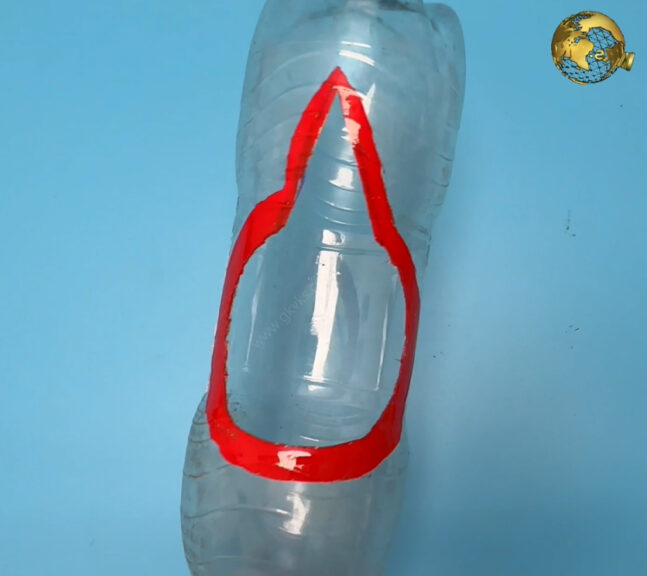
- Fruit Picker Model 2:
Take a 2 litre plastic bottle
Remove any labels or stickers on it.
Mark a circle with a diameter of about
3 to 5 inches depending on the fruit you wish to pick.
Mark a beak on the circle towards the bottom of the plastic bottle.
Cut this out carefully to create a hole of this shape.
Fix the bottle to a pole or a pvc pipe of your desired length. Your simple fruit picker model 1 is ready to pick fruits.
- Air Pruning Pot:
Air pruning means when root tips are exposed to air, the root tips are effectively “burned” off, causing the plant to constantly produce new and healthy branching roots. promoting more branching of roots. If roots are not exposed to air, they continue to grow around the container in a constricted pattern making them root bound. Hence air pruning promotes better growth of plant within a limited space.
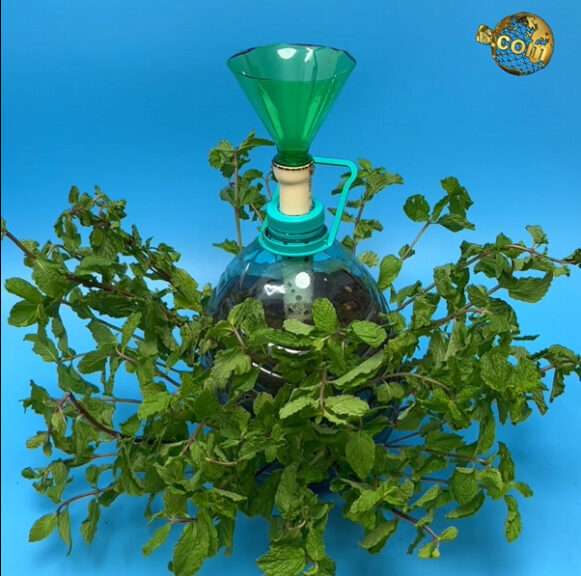
To build an air pruning pot you need a larger plastic bottle like atleast a 5 litre can. Remove any labels or stickers. You also need a pvc pipe of about 1 inch diameter and 1 foot height. Mark a circle on the bottle cap and cut it out. This is to insert the pipe through it. Make multiple tiny holes on the pipe. Any number of holes, the more the better. Put a cap at the bottom of this pipe. Take another smaller plastic bottle. Mark and and cut out a funnel. Fix this funnel to the upper end of this pipe. Screw it tightly.
Now cut a small window of any shape on the bottle. Then make multiple holes to insert your cuttings over the bottle below the level of this open window. Insert the pipe into the bottle and cap it. Add potting mix into the container. Make sure it contains atleast 30 to 40 percent compost. Your air pruning pot is ready. Now you can insert some mint cuttings into these holes. You can water every alternate day through the top funnel. You should see nice and fast mint leaves growing in about 2 weeks using the principle of air pruning.
- Easy Plant Cloner:
You can root your cuttings faster using this simple plant Cloner. Take any plastic bottle. Remove any labels and stickers. Punch multiple holes around the bottle, large enough to insert cuttings easily. Take some of your plant cuttings. Make sure you make a cut at an angle of about 45 degrees for faster rooting. Insert the cuttings into the holes. You can tape the cuttings to hold in place or tie a string around the bottle to hold the cuttings. Pour water into the bottle. Add a little bit of rooting hormone powder if you have. You can also add about half a tablet of Aspirin 350 mg dispersible tablet to induce faster rooting. If you want to further accelerate the rooting process, place air stones into the water and connect to an aquarium pump. Switch it on for few minutes for atleast twice daily. This oxygenation helps promote rooting faster. We have made similar advanced Cloners earlier using the principles of hydroponics. You can check HERE.
Simplest method of slow drip irrigation is using one bottle per container. Just make a tiny hole into the cap. Full the bottle and insert into the pot for vacation watering of already 7 days. Make sure you make a small hole at the top of the inverted bottle for drip to flow through.
Another alternative is to use these little bottle attachments with a drip control knob to adjust the number of drops per minute. Just fix it to the bottle and insert it and adjust the drip knob.
- Easy Plant Watering Systems.
Model 1: this nozzle can is recommended for your expensive succulent plants for careful watering without wetting the leaves and thus avoid fungal rot. Take any plastic bottle. Make a hole in the cap and fix a pipe into this hole and glue it from the inner side.
Model 2: this is just a simple shower bottle. Make multiple tiny holes in the bottle cap. That’s it. This is especially useful to water your seeds and seedlings and avoid heavy pressure of your garden hose damaging the seeds or the little seedlings.
- Easy Spray Bottle:
Model 1: take any plastic bottle and fix this type of simple hand pressure trigger nozzles to spray pesticides or foliar feeds on your indoor or outdoor plants.
Model 2: you can also attach an adjustable pressure nozzle or pump type of nozzle easily available online at amazon.
- Ring Guard:
Cut out few rings like these from plastic bottles. Use these around seeds and seedlings to prevent Slugs and Snails crossing over and eating your little plants.
- Mini Greenhouse:
Cut the tops off the plastic bottles. Remove the caps and cover these over seeds. This creates a mini greenhouse effect with nice humidity to germinate seeds faster.
- Easy Funnel:
Cut the tops off the plastic bottles as done in the previous hack. This is an easy funnel to transfer either seeds into a container or potting mix or even watering, mixing pesticides and so on.
- Self-Watering Pot:
You need one large plastic bottle. Make the markings and cut it through. You get two pieces. The bottom one is the water reservoir and the upper part is the actual pot to grow plants or seeds. Optinally you can paint this for good looks. Now take a piece of cotton rope. Make two holes in the bottle cap and insert the cotton wick through it. The lower end of the wick should be placed in the water reservoir.
You have two cotton wicks now. Now fill with some potting mix to about half and bury one wick. Then add more potting mix and then bury the other wick. You can plant seeds or small plants into this. Whenever the soil gets dry it will suck the water through the string and keep the soil moist.
12. Plant Labels:
Just cut some strips off the plastic bottle and use them to label your seeds or plants.
- Seed Storage:
Plastic bottles are excellent for storing your left-over seeds. Just pour the seeds in a bottle and close the cap. Make sure you place a small sachet of a silicon desiccant for any moisture absorption to prevent fungus.
- Bird Water Feeder:
Take a plastic plate or a small tray. Fix the bottle cork to the center of this tray. Bolting this is a good idea to make it sturdy. Also try to prevent any leaks by sealing with glue. Make holes like this near the bottle mouth. Fill the bottle and cork the tray to the bottle and invert this set up. You can hang this simple DIY water feeder for birds in your garden using some strings and attract beautiful birds to your garden.
- Easy Planters:
Model 1: For growing Greens. Take a large bottle and cut out horizontally. You get a wider container for growing your greens. Fix a cap at the bottom with the help of some screws. Optionally Paint it or decorate it as per your wish. Make few drainage holes at the bottom. Fill it with potting mix and plant your seeds.
Model 2: Cut a bottle near its base like about 5 to 6 inches from the bottom. Optionally pain it or decorate it as per your wish. Make some drainage holes. Fill it with potting mix and grow seeds or some small plants.
In Today’s post, let us look into 15 household items and their miraculous uses for plants and garden.
15. Soap: Bar soap apart from cleaning purpose, there are some really powerful uses in gardening. You can scrape your nails into a bar soap before handling a potting mix and stuff like that. The dirt won’t enter your nail beds and this hack allows you to clean your hands easily after the job.
Liquid soap or even shampoo is used as a simple pesticide if you do not have any pesticide. Just add 10 to 20 drops or 1 or 2 teaspoons of liquid soap to 1 litre of water and spray on the affected plant. This will clear pests like mealybugs, whiteflies and aphids which are the most common pests in garden. Dish washing liquid soap is actually more potent than handwash liquid soap.
14. Chalk Sticks: Chalk is chemically Calcium Carbonate. You can take white chalk sticks and bury them into the soil while planting your veggies. That’s in initial stages. This really works wonders for plants like Tomatoes, Peppers, squashes, egg plants and almost any vegetable plant. You can bury two chalk sticks per container for these vegetable plants safely if you soil PH is around 6.0. For other plants to provide slow release calcium source, you can bury one chalk stick per container.
13. Turmeric: Turmeric powder has many effective uses in garden like: It repels ants when sprinkled around the plants. You can get rid of soil pests particularly fungal root rot and fungus gnats in the soil by mixing turmeric in soil. You can mix about 1 tablespoon per gallon of soil while making potting mix or 1 tablespoon of turmeric in 1 gallon of water or 1 teaspoon per liter of water and thoroughly water your affected plant with this solution. Its also helpful in healing tree wounds and in grafting as it prevents fungal rot. Another common use of turmeric is in rose die-back disease.
12. Vinegar: You can use vinegar to clean your rusty garden tools and pots. To make your soil more acidic for acid loving plants like hydrangeas, rose, hibiscus and so on and increase flowering in these plants. To do this, Mix one table spoon of white vinegar to one litre of water and water you acid loving plants with this solution once every 15 days to reduce the soil PH. Vinegar is also a strong pesticide. Its almost 100% effective in clearing powdery mildew fungus. To make this spray add One cup of White Vinegar to 1 litre of water and shake well and spray it on the affected leaves. It is also effective against white files and mealy bugs. It is also an animal repellent. Just soak some pieces of cloth and stuff them at entrances or behind pots to deter animals that can spoil your garden.
11. Baking Soda: Apart from cleaning your dirty garden tools and stuff with baking soda, you can also use it for other purpose like sprinkle to drive away Foul Smell from your Compost Pile or compost bin. To kill cabbage worms – Sprinkle Baking soda + flour like wheat flour in 1:1 ratio on the cabbage or broccoli leaves. The worms munch on this and die within 1 or 2 days. Baking soda also encourages flower blooming. Make a solution of 1 teaspoon baking soda in 1 litre of water and spray on your plants with flower buds or unopened flowers.
10. Asafoetida or Hing: The most effective use of asafetida is to treat leaf curl disease in plants. Add 5 gms of asafetida powder to one liter of sour butter milk. Mix well, leave for an hour, then sieve the solution and load your spray bottle. Spray over your affected plant. Repeat this every 3 days for 3 – 4 times. Leaf curl disease which is common in pepper and tomato plants will be completely cured by this treatment. Asafoetida can also be used to repel animals in your garden. Just hang some pieces of it in your garden entrances. Animals hate the pungent odor of asafetida. It also repels other insects and termites.
9. Charcoal: Hard wood charcoal has lots of amazing uses in garden like filling your pot bottom with charcoal pieces reduces pot weight. It can be used for mulching and garden décor. Mixing charcoal in soil can act as a good fungicide and prevent root rot, especially for expensive succulent plants. It also increases soil PH, when your soil is too acidic. It also works as a soil conditioner making the soil well draining. It also hold the fertilizers added for a longer duration and make them act like slow release fertilizers. Sprinkled charcoal powder helps deter many insects like the voracious beetles which can create havoc in your garden or on your crops.
8. Alum: Alum or Potash Alum can help to boost flowering. It makes the soil acidic for acid loving plants like hydrangeas, rose, hibiscus and so on. Just 5 gms alum powder per litre of water and water your plants once in a month. Alum is also a good pesticide in higher concentrations, like 100 grams per litre of water and spray on the plants to kill many pests including cabbage worms, cutworms, slugs and snails, etc. It is well known for mostquito control as a larvicide when sprinkled over the stagnant waters.
7. Banana Peels: Banana peel is one of the highest organic sources of potassium. It helps strengthen the plant and increases flowering and fruiting. You can make banana peel tea or banana peel fertilizer powder if you intend to store it. To make banana peel tea, soak pieces of banana peels in water for about 3 to 5 days. Use this banana tea in 1:5 dilution to water your plants once in a month. To make banana peel fertilizer powder, sun dry pieces of banana peels for 2 to 3 days till they are crispy enough to make a powder. Add one tablespoon of this powder once in a month and see the effect.
6. Aloevera: Aloevera has numerous benefits not only to the human body, but also to plants, like: It helps in faster rooting. Just insert a cutting into a piece of aloe vera and plant into soil. Rooting is faster and success rate is higher. Diluted aloe vera gel sprayed or watered to your seeds helps in faster and healthier germination. High levels of certain compounds found in aloe vera confer immunity or resistance against many plant diseases. Aloevera can also be used as a potent pesticide if mixed with other agents like neem oil, especially for pests resistant against certain pesticides.
5. Onions Peels: contain many useful substances like sulphur, quercetin, potassium, phosphorus, zinc, and so on. So, do not throw away the onion peels. The simplest use of these peels is to use them for mulching. If you have time you can make a fertilizer out of these onion peels. Just soak the peels in water for 1 to 2 days and water the solution to your plants once in a month to notice the benefits.
4. Tea and Coffee Waste: Do not throw this away. It can certainly boost flowering in your plants. It contains tannic acid which helps plants like Rose and hibiscus to increase flowering. You can wash the waste for any sugars and directly add to your plants or collect this and sun dry this powder and use it for your plants. You can also add this waste directly into your compost bin for making a rich compost.
3. Cinnamon: Cinnamon powder from your kitchen is well known for its wonderful uses in gardening. It can be used as a rooting agent to increase the chances for rooting cuttings. Just dip the cutting into cinnamon powder and plant it. It also deters ants when sprinkled around your plants. Its antifungal properties also fight fungal attacks to your seedlings. Just sprinkle fine cinnamon powder over your seedling and prevent dampening off.
2. Eggshells: Though eggshells are a great source of calcium, do not add crushed egg shells directly to your plants. It takes many years to decompose and release that calcium into the soil. You need to instantly release this calcium from eggshells by using Vinegar. Make eggshell powder first and then add a cup of vinegar to it. Stir it well and leave for an hour. The acetic acid breaks the eggshell compound and release free calcium into this solution. You can then dilute this solution to 1: 10 or 1:20 and then water your plants to treat or prevent acute calcium deficiency problems like tomato blossom end rot disease and other problems like bud or flower or fruit drop off and increase your flowering and fruiting. You can also add egg shells to compost bin for a calcium rich compost.
1. Aspirin: Aspirin is acetyl salicylic acid. Salicylic acid is a plant auxin and a rooting hormone which is proven to accelerate rooting and also it confers immunity against many plant diseases. You can use a dispersible 350 mg Aspirin tablet. Just a little of it will do the trick. A quarter or half a tablet is sufficient. You can read all detailed articles on these individual stuff by searching our website for that particular stuff.
Having a beautiful, lush green lawn is every gardener’s dream. It really makes your home and garden landscape look beautiful.
We would all like to have that best-looking perfect lawn, but it is not always easy to achieve. Here in today’s episode, we will show you step by step, how to grow lawn grass successfully from seeds without the need of hiring a landscape designer and stuff like that.
Whether you want to fill a bare spot in your lawn or grow a brand-new lawn grass from the scratch, please read till the end, as it might surprise you with lots of useful tips and tricks. Let’s begin.
- Type of Lawn Grass Seeds?
This is the first important step where most inexperienced gardeners and home owners get deceived while purchasing grass seeds.
PURCHASE LINKS:
BERMUDA GRASS SEEDS: https://amzn.to/3P5npAr
There are many different grass species which thrive in different climates. Like, there are cool-season grasses which grow best when temperatures are 60-75 degrees Fahrenheit and warm-season grasses which thrive from late spring through summer. You can check the packet instructions and labels for this info.
Well, some of the common grass types to mention are Bermuda grass or doob grass, buffalo grass, bentgrass, ryegrass and so on. In this context I would like to highlight you on this important lawn grass seed scam mostly going on online even at big websites like amazon. Some sellers list out as Bermuda grass and the seeds you receive are some millet seeds like foxtail millet seeds or cattle fodder grass seeds which are actually very cheap. These types of seeds are usually fed as budgie food grains but they are selling as Bermuda grass seeds. You must know how to identify the proper seeds before planting and avoid these types of scams. These are mostly non-returnable items and also amazon does not publish negative reviews when we try reporting these fake items. We will grow these fake seeds in one container and genuine Bermuda grass seeds in another container as well as over the lawn area and show you the results in the end.
PURCHASE LINKS:
BERMUDA GRASS SEEDS: https://amzn.to/3P5npAr
- Preparing the Ground and Soil:
This is a very important step and you should know that the tender roots of young grass plants will not grow well in compacted soils.
Choose the location you want to grow lawn grass whether its your front patio or your back-yard. Optionally, You may also have to level the ground surface by adding some loose soil over your lawn area, days before planning your lawn grass.
Well, Firstly, loosen the top 2-3 inches of the soil. If it’s a small area, you can use a hand cultivator or if it’s a larger area you can dig with a shovel or hoe. After digging, you need to rake it smooth to break up any soil clods and rake the soil out into fine particles. Then you need to water the area thoroughly before planting seeds, because damp soil encourages speedy germination and provides immediate moisture to emerging roots.
- Planting the grass seeds:
For home gardens, you can just use your hand to distribute the seeds, flinging it out over the area. Spread them out evenly over the soil surface, neither too crowded nor too sparse.
- Covering the seeds:
After the seeds are sown, covering them is very much important to protect them from birds and also preventing them from washing away in a heavy rain.
You can just use plain soil to cover the grass seeds after planting. But best thing to do is to use a mixture of soil and a water retaining stuff like cocopeat or peat moss to cover them. Like 50% soil and 50% cocopeat and optionally compost like decomposed cow dung or vermicompost. You can mix all three in equal proportions or at least add some 20% compost. Cover the seeds evenly with this soil-peat mix to about one quarter of an inch but never more than half an inch.
- Watering:
This is most important step for germination.
Keep the top layer of soil moist (but not soggy). Too much water is as bad as too little, and avoid vigorous watering with a hose and stuff like that and this could wash the seeds away. A misting or shower attachment on your watering hose can cut down on the amount of force you use.
Till germination, Water at least once a day early in the morning and depending on the climate again in the afternoon if the sun and wind have dried out the soil.
But, once the grass seed germinates and begins to grow, reduce the frequency of irrigation but water more deeply. Once your new grass is about two inches tall, reduce your watering schedule to twice or thrice a week depending on the climate, but water until the ground is wet down to a depth of about three inches.
- Germination:
We will show you the results of seeds grown in containers as well, including the fake bermuda grass or fodder grass seeds.
PURCHASE LINKS:
BERMUDA GRASS SEEDS: https://amzn.to/3P5npAr
Germination should begin within a week depending on the type of grass seeds. In my case, you can see germination has happened within 3 days. On the third day, you can see these cute tiny grass seedlings popping out.
You can check the results in these containers. On Day 5: This one is the result for genuine Bermuda grass and this one is the fake Bermuda grass seeds. Just look at the grass blades and spot the difference. The fake fodder grass has wider leaves.
Then you can see the results after 1 week in containers and the ground. The whole area should appear green in about 2 weeks’ time.
We will make another detailed episode on how to take care of lawn grass like fertilizing lawn grass, trimming lawn grass and stuff like that.
Bonsai is an increasingly popular art of growing miniature live trees. Many people would love to own and grow a bonsai tree themselves. But You will need the right tools and right techniques to accomplish this. You will find that, most bonsai tools like scissors, shears, rakes, hooks, etc are quite expensive, may be because they are made in Japan or may be the demand and supply issues.
Let’s begin!
- Bonsai Rake Tool Hack: A stainless steel bonsai raking tool is an expensive tool. Simple free solution to this is to convert a stainless-steel dining fork to make a bonsai rake. Just insert the fork tines under a door or any sturdy slot and then gently bend it to your desired level to make a bonsai rake tool. Raking the top soil is a healthy gardening practice which has a lot of benefits.
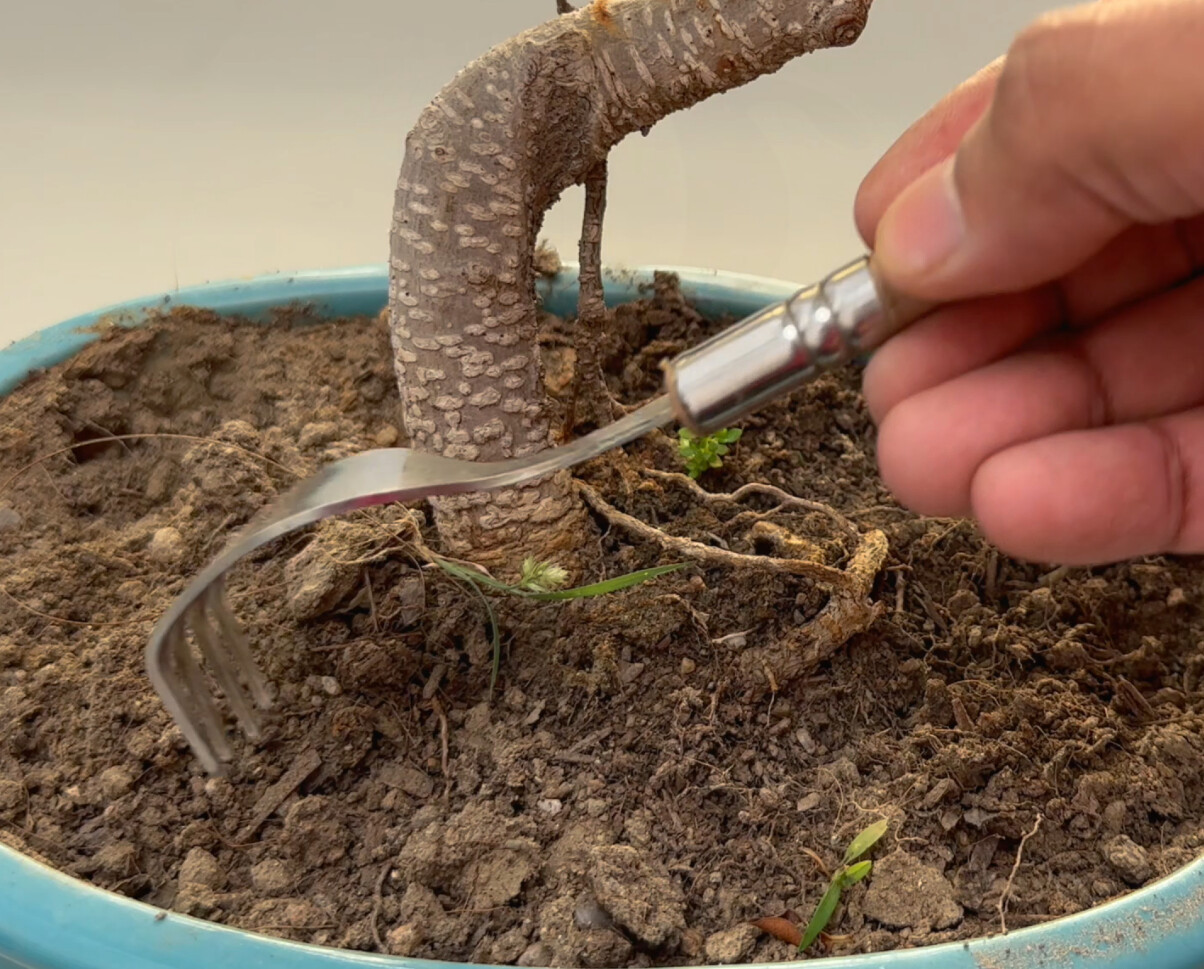
- Wound Sealant Hack: Bonsai would sealant paste is very expensive. A simple alternative to this is to use universally available Fevicol paste. If you want to make it more effective, you can add some antifungal powder to Fevicol paste and apply to larger bonsai pruning wounds.
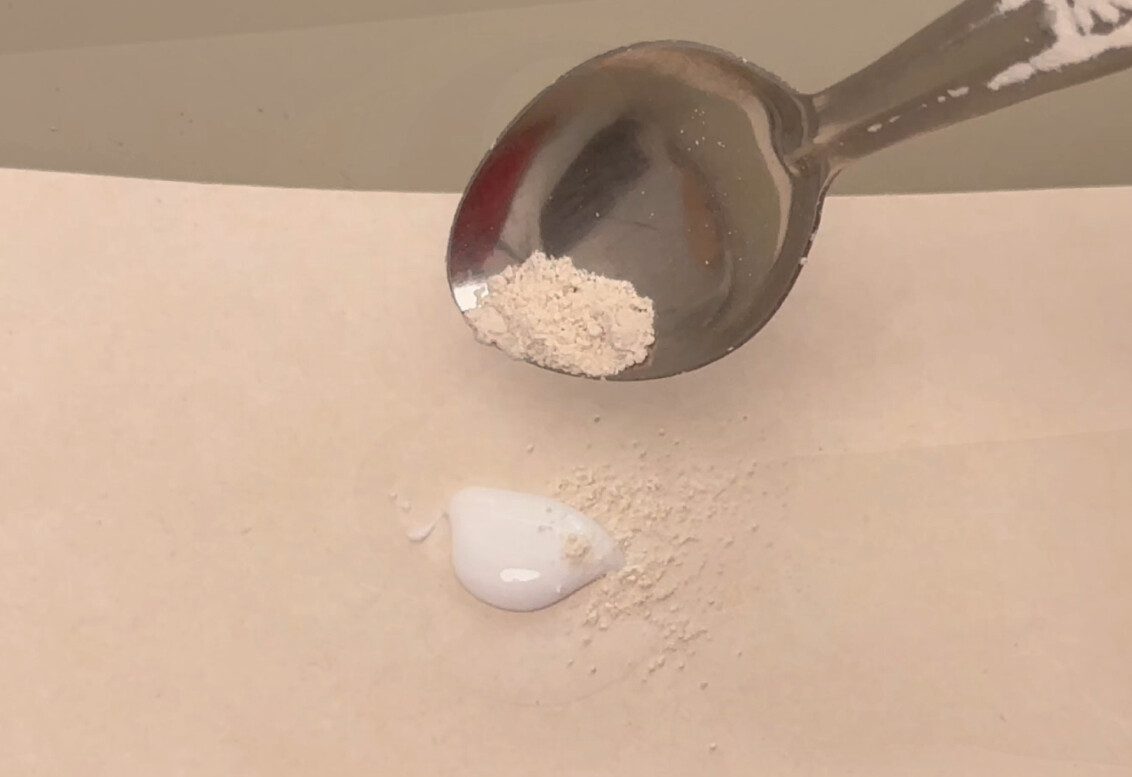
- Bonsai Turntable Hack: Bonsai Turntable is a very useful and a must have tool for anyone working with bonsais. If you do not have a professional bonsai turn-table, the cheapest alternative is a cake turntable which can efficiently work for smaller bonsais. Another hack to make a heavy-duty turntable for larger bonsais is to use the bottom steel base from an old or broken revolving office chair.
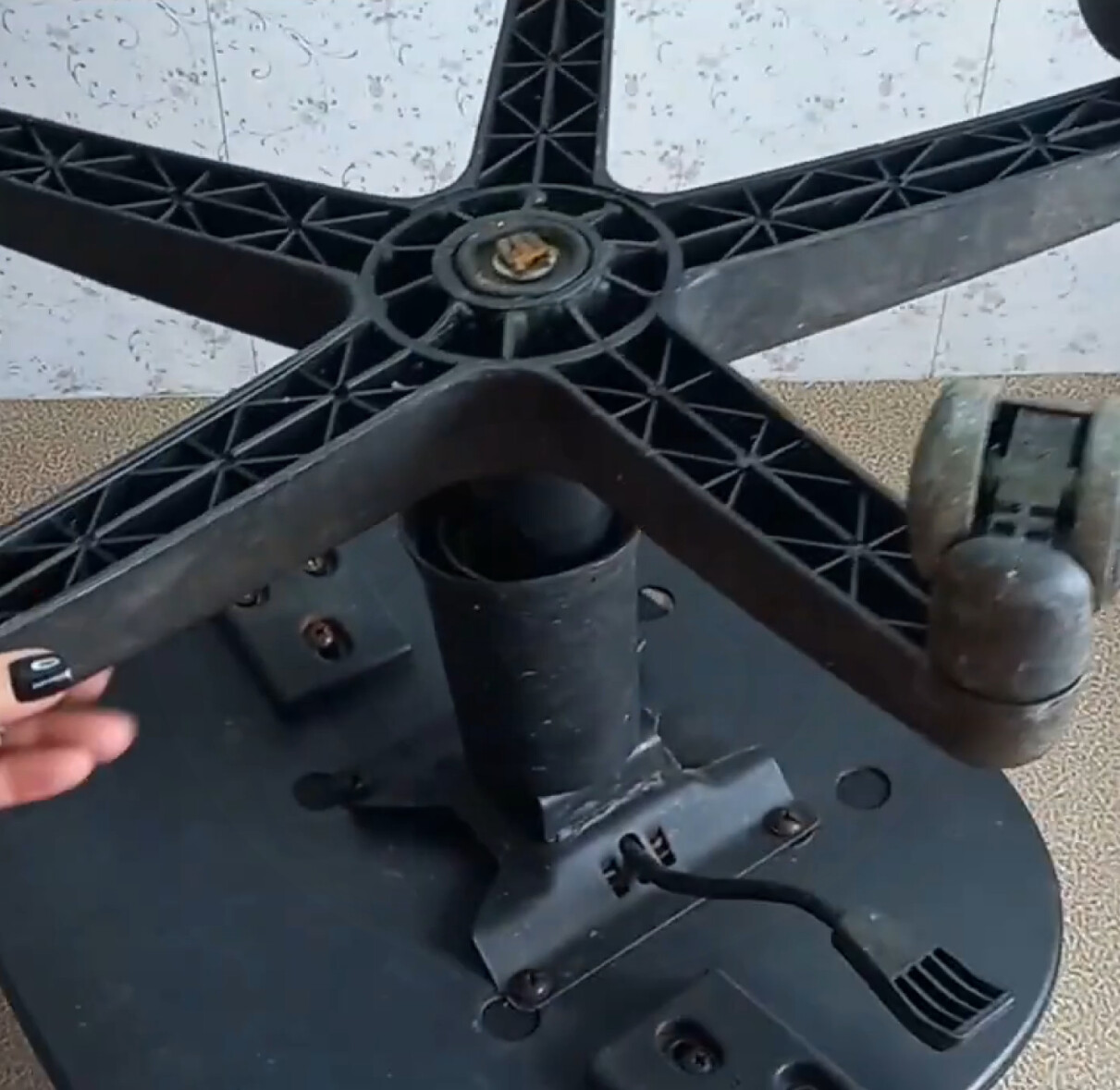
- Bonsai Wire Hack: if you do not have the professional bonsai wire to shape your bonsai branches, an easy alternative is to use thick gauge electric wires. You can use left-over pieces of old electric wire of different gauge, to wire and bend branches easily. But never use a GI wire like this one to wire bonsai, the obvious reasons are they are prone to rusting and difficulty in removing it when you want to, as they can adhere deeply into the stem or branch.
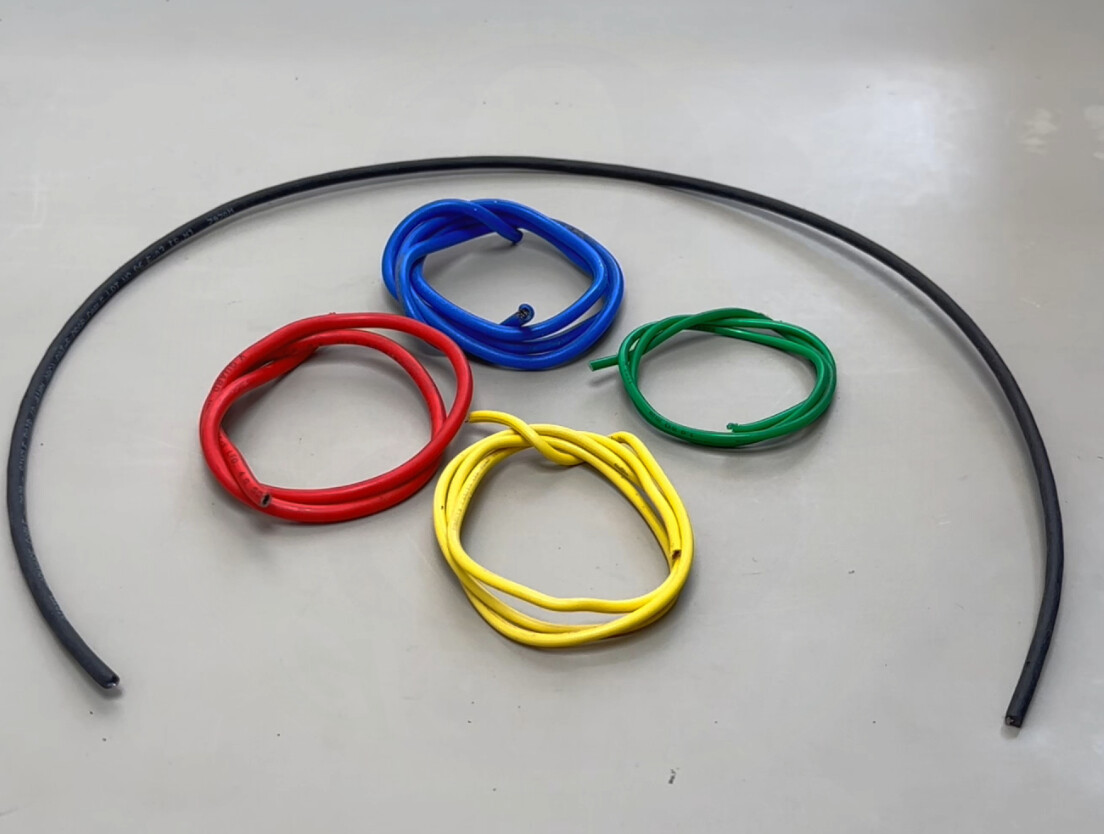
- Thick Woody Stem Bending Hack: It is next to impossible to bend a thick woody stem or a branch. You all know how important are bends or curves in bonsai tree designing. This bending technique is very important for making instant bonsais, especially from air layering technique which we shall discuss it later. If you have a thick branch or stem to bend, you can use a pruning saw or if the stem is not so thick, you can use a simple hack-saw blade to make multiple small wedge shaped cuts with a gap of about 1 inch between the cuts. You can vary the number of cuts or the distance between these cuts depending on how acute you want the bend. Make sure you don’t make too deep cuts, about 50% cut through the stem is fine. Then bend the stem or the branch to approximate or merge these cut wounds. To hold the bent stem in position, use a wire to support this stem or branch. Then wrap the wounds tightly with an aluminium foil first, to prevent moisture loss and promote proper healing of this wound, then wrap a grafting tape or a thin polythene sheet over this and then if you wish, put another layer of tape around it. Keep it undisturbed in partial shade. It should heal in about 4 to 6 weeks and your bonsai stem shape is done!
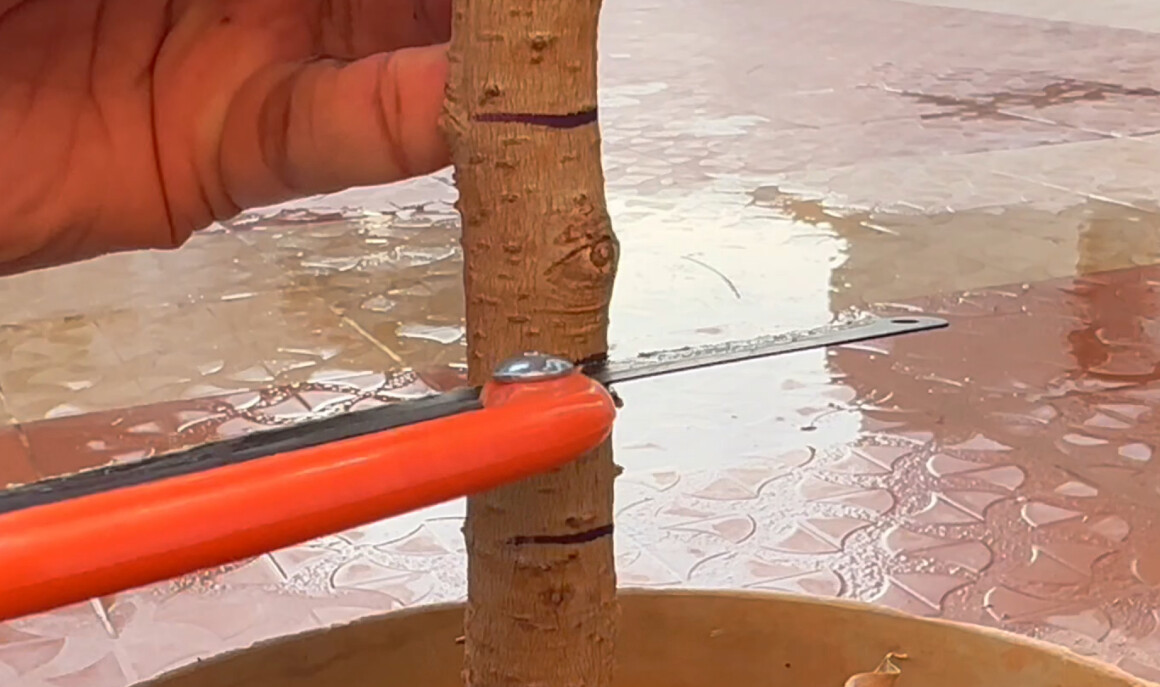
- Branch Splitter Hack: Bonsai Branch cutters or splitters are indeed expensive tools. In fact, almost all bonsai tools are expensive. You can make a bonsai branch splitter by grinding a cheap nail puller tool available at any hardware store. Carefully look at the image of the bonsai cutter blades and sharpen them in the same way. If you have good grinding skills, you can also make a parrot beak or bonsai concave cutter which is a very useful bonsai tool. Branch splitters are used to split thick branches, which helps to bend thick branches.
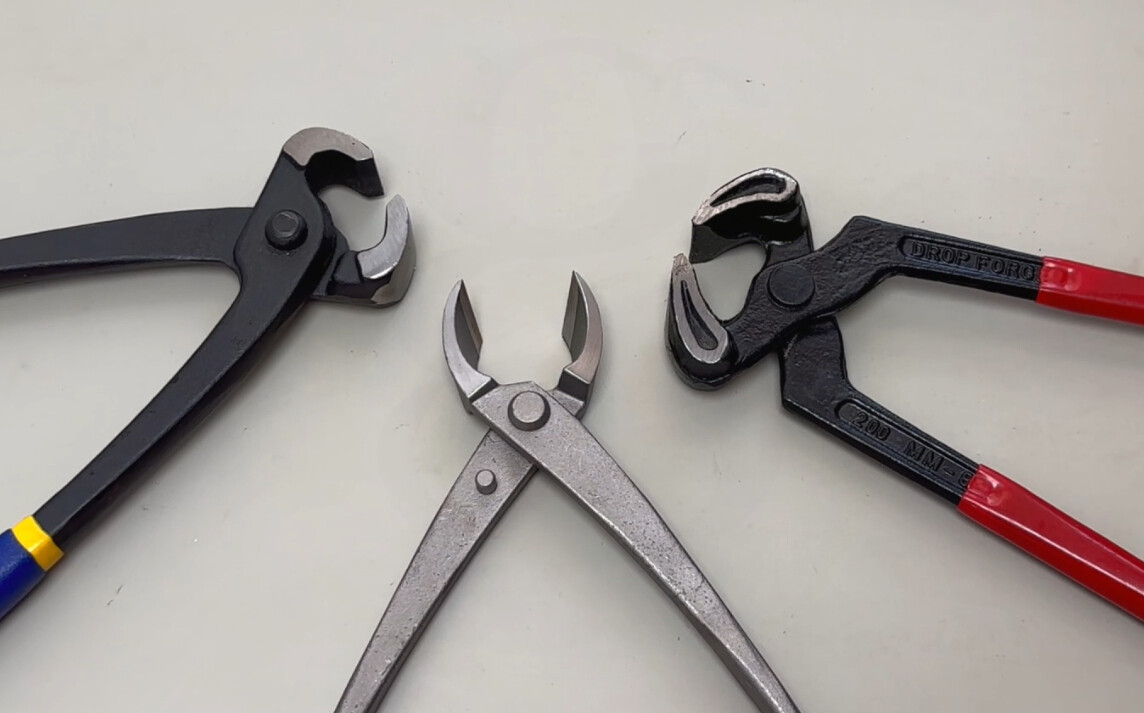
- Bonsai Scissor Hack: stainless steel bonsai shears and bonsai twig scissors are again expensive tools. A simple alternative is, to use surgical scissors with long blades as twig shears. These surgical scissors are very durable and do not rust so easily.
- Bonsai Root Rake Hook Tool Hack: Bonsai root hook is an indispensable tool needed while repotting bonsais. A simple way of making a bonsai root hook is to use large sized J hooks like these, which are cheap and easily available from a hardware store. You can sharpen the working point of this hook to your desired level. Now you need a handle to fix this hook. You can just use any wooden piece to make a handle, but the best solution to this is use a paint brush handle from an old paint brush. Just cut this part and make a hole into this handle and insert the hook and screw it tightly. You can then bend this hook to your desired level if needed. That’s it! Your bonsai root hook is ready to rake the roots.
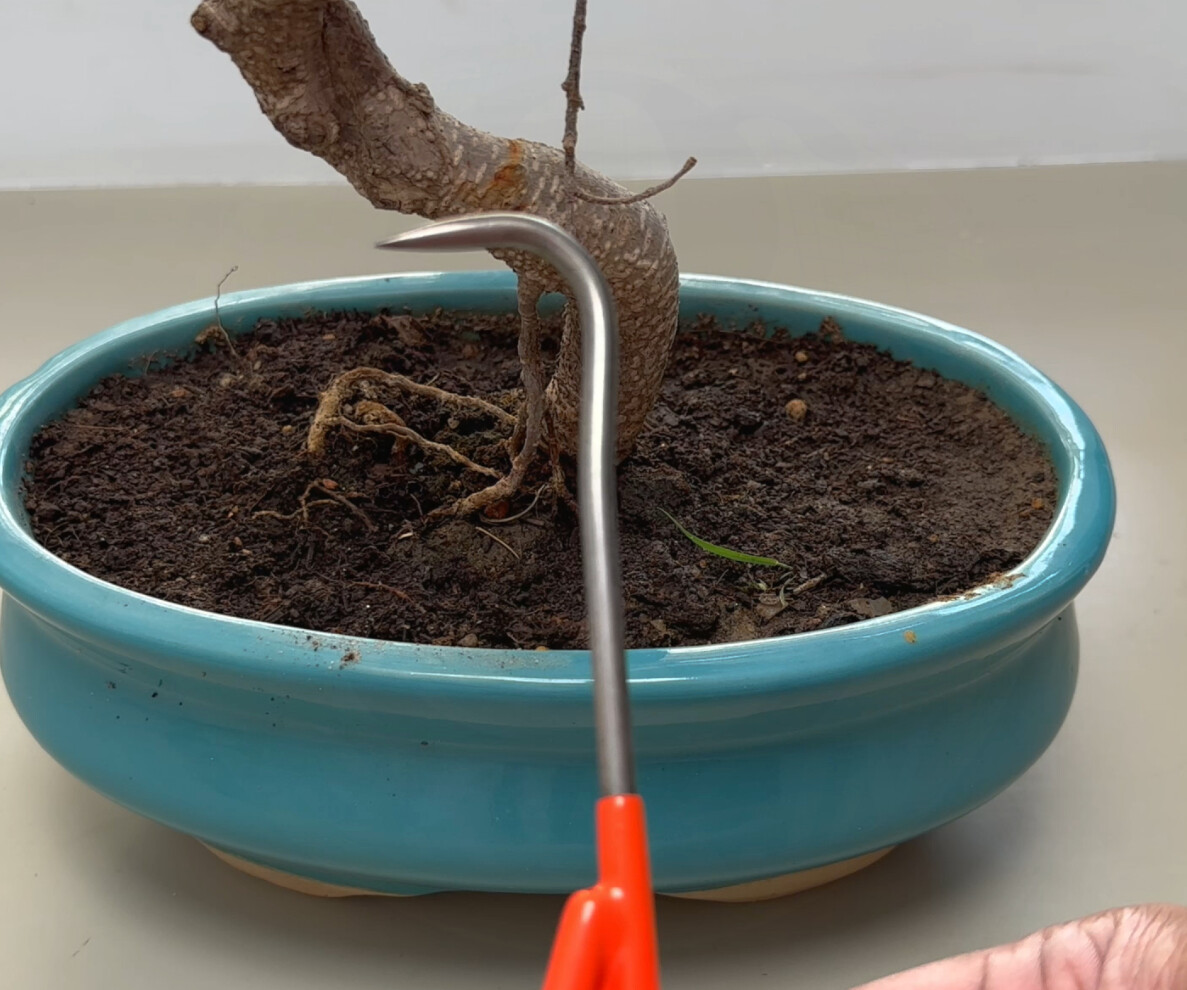
- Thick Stem Hack: for faster development of a thick stem or trunk of any plant, you can place your pre-bonsai plant pot on a layer of gravel bed over the soil. The plant grows faster and thicker by sending out roots into the gravel bed through the drainage holes.
- Instant Bonsai Hack: As you all know making a true bonsai tree takes many many years if you are starting from a seed or a sapling. The quickest way of making and designing a thick bonsai tree is Air Layering technique which gives you an instant live bonsai tree to work on and save many years of work required to make a bonsai tree. You can check a detailed post and video on 5 different types of air Layering and some air layering tricks and hacks from HERE.
Happy Gardening and Happy Bonsai Making. Watch Full Bonsai Hacks Video below:
Aloe vera is sometimes known as “the plant of immortality” – because of its properties to heal, soothe, and refresh. This is because Aloe vera is rich in nutrients, enzymes, and antioxidants that offer numerous benefits to the human body. So, what if I told you that aloe vera can provide many of those same benefits to plants too? Yes! It’s true! Let’s list out the top 6 benefits of Aloe vera for plants and your garden.
6. Seed Germination: Aloe vera is not only a rooting agent, but also promotes healthy seed germination and strong seedlings. Watering your seeds and seedling once in a week will improve the overall growth and yield. Mix 1 teaspoon of aloe vera gel per litre of water or 1 table spoon per gallon. Spray this over the seedlings or water them once weekly.
5. Plant Immunity: Aloe vera gel is fully loaded with over 75 beneficial useful nutrients and enzymes like amino acids, antioxidants, calcium, magnesium, zinc, salicylic acid and so on. High levels of acemannan and saponin found in aloe vera both provide antibacterial, antifungal, and antiviral properties. This helps to protect plants and confers resistance or immunity against certain harmful microbes, fungi, yeast, mold, blight and so on. Just water the plant once in a while – like once in a month with aloe vera solution and see the difference. It not only gives resistance against diseases but also boosts overall growth and health of the plant. Add 1 table spoon of aloe vera gel per litre of water or a quarter cup per gallon of water, mix it well and water your plant. If you start this in early growth stage of a plant, it’s actually much beneficial in the long run.
4. Transplant Shock: Certain high levels of antibacterial, antifungal, and antiviral compounds found in aloe vera help plant recover from transplant shock. A plant goes into Transplant shock when you repot it or transplant it from one place to another. The plant looks wilted and unhealthy after transplant. To help recover from this shock, you can water your plant with aloe vera solution at least once after repotting. Repeat after 3 – 4 days if necessary. Add 1 table spoon of aloe vera gel per litre of water or a quarter cup per gallon of water, mix it well and water your plant.
3. Fertilizer: You can either make a soil drench or a foliar spray. To make a soil drench, take some fresh aloe vera leaves and cut them into pieces and throw them into the blender and add some water. You don’t need to peel them. Add half a cup of this gel to one gallon of water or 2 table spoons per litre of water and water your plants with this solution once 15 days. Make sure you drench this within half an hour of making, because if exposed to air, fresh aloe vera quickly ferments and begins to degrade.
The second preparation is a foliar spray or foliar feeding your plants to help them absorb these beneficial nutrients directly through the leaf stomata. You need to make a fresh aloe vera solution like one table spoon per litre of water or quarter cup per gallon. You can sieve this to prevent your sprayer getting clogged. Mix it well before spraying. Spray more on the underside of the leaves because leaf stomata or openings are more concentrated on the underside. Spray this in the evenings to avoid quick evaporation in the presence of sunlight.
2. Natural Rooting Agent: The salicylic acid and other anti-bacterial and anti-fungal compounds help promote rooting faster. There are many methods to use aloe vera for rooting: Let’s look at them one by one:
a. Dipping the cuttings into fresh aloe vera gel and inserting into soil. I recommend you soak the cutting for few hours into aloe vera gel and then plant the cuttings into soil. This will not only promote faster root development but also the success rate of rooting cuttings is high because aloe vera fights fungal rot.
b. Second method is just inserting the cutting into a small piece of aloe vera leaf and plant the whole thing into the soil to achieve the same results.
c. A piece of aloe vera can be used for Air Layering to multiply your favourite plants with great success rate. Just wrap a piece of aloe vera leaf and wrap around soil or toilet paper and tie the ends.
1. Pesticide: Aloe vera alone may not act as a potent pesticide to fight all pests and diseases. You need to other natural agents to make it a powerful organic pesticide that fights common garden pests like aphids, mealybugs, whiteflies and so on. Let’s quickly learn how to make this organic pesticide using Aloe vera leaves plus 5 more ingredients from your kitchen.
– Take Fresh Aloe vera leaves and cut into small pieces and drop approx one bowl into your blender.
– Drop four to five green chilies.
– Add 1 large onion.
– Add 1 full garlic.
– Add one bowl of Neem leaves if you have.
– Add 2- 3 teaspoons of Turmeric powder or fresh turmeric rhizomes if you have.
– Add a cup of water and blend into a fine paste.
– Sieve this solution and collect the extract.
– Mix 100 ml of this to one litre of water or 300-400 ml of it per gallon and spray it on the affected plants. Repeat this after 4 to 5 days.
I am sure most of us have failed many times trying to propagate roses from cuttings. Rooting Rose stem or branch cuttings needs some special care and application of certain hacks and tricks unlike other plant cuttings which are easy to grow. And you get a genetically identical copy of your Parent tree which is not the case with seed grown plant, which differs significantly from its Parent plant.
Whether you are growing rose cuttings in water or in soil, use these common tips and tricks that will give you the best results.
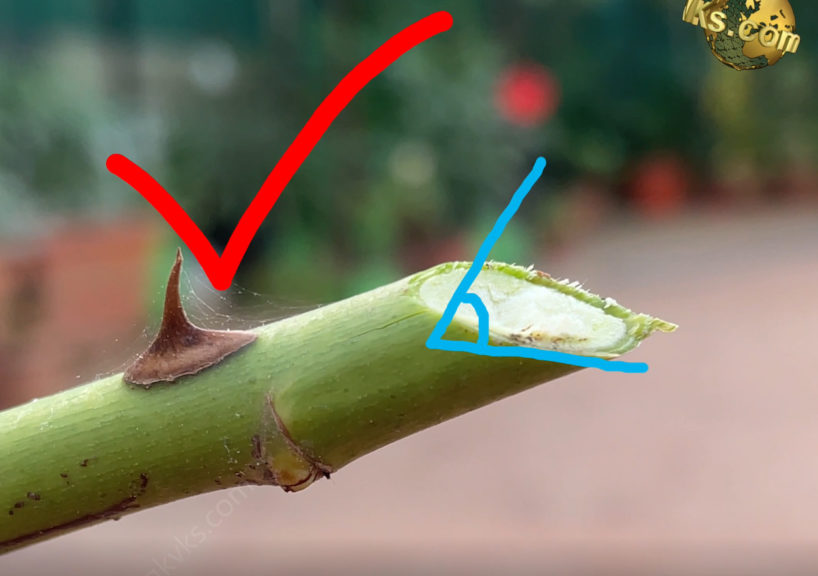
- The Best Cuttings: – The first and foremost criteria to choose cuttings is selecting a disease-free branch. Make sure you choose a healthy branch free of any disease like rose die-back disease or any fungal black spots or white spots. If you choose a diseased branch, the rooting will certainly fail. Secondly always choose semi woody cuttings from the branch which is healthy with young shoots and leaves at its tip. Semi woody means – neither too hard nor too soft and young.
- Length of the cutting: This is very important and should neither be too long nor too short. An ideal length for best results would be 6 to 8 inches or max 10 inches. This length also depends on the internode distance of a branch which varies with the plant species. Remember one rule of thumb: the success rate of rooting is inversely proportional to the inter-node distance. That means the lesser the internode distance, the greater the chances of success.
- Cutting Tricks: – Firstly the Cutting Tool: A clean and sharp cutting blade or pruner is important. So, disinfect it using hydrogen peroxide swab or any household disinfectant you have. A germ-free cutting is shown to produce great results.
- Secondly the Cutting Point: Make a sharp cut about half to one inch below a node. This is where the rooting starts. Do not make a crushing cut which can damage the plant tissue and the outcome may be poor.
- Thirdly the Cutting Angle: A 45 degree cutting angle using a sharp and a clean cutting tool is shown to provide the best results and faster rooting because this gives the maximum surface area to produce roots and also it helps the cutting to absorb water quickly.
- Removing Leaves & Flowers: Remove the lower leaves and leave only a pair of top leaves. Cuttings do not have the root system to take up water yet, so fewer leaves means less stress on the cutting. Also Remove any flowers on the branch by snipping of dead or any flowers along with its twig. This is to divert energy to root development.
- Sealing the Top: This simple hack gives best results by retaining the moisture within the cutting and thus increasing the success rate. Simply light a Candle and pour on few drops of wax on the upper end of the cutting to seal it to prevent moisture loss from this top end. Check out my 100 Gardening Hacks Post.
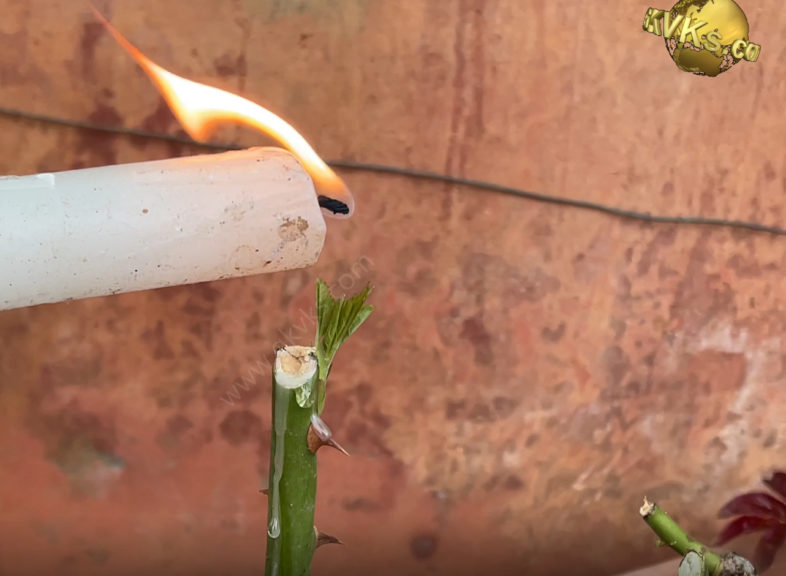
- Orientation: Make sure you insert the cuttings in proper orientation and not reverse, especially if the cutting does not have any leaves on it. You can identify this by looking at the orientation of thorns and nodes.
- The Growing Medium: This is very important. If you are rooting in water, the container water should be changed every 4-5 days or at least weekly to prevent contamination and infection. If you are using Potting soil, use a loose or well-draining soil for faster root development. You can choose a sandy soil, cocopeat or peat moss, perlite and stuff like that. Or you can make your own potting mix using all these stuffs or whatever available.
- Insertion depth: How deep should I insert the cuttings. This is another important factor to consider. An insertion depth of 2 inches is considered better, one reason perhaps is better anchorage into the soil and keeps the cutting less disturbed.
- Rooting Hack: This simple rooting hack will help not only get faster results but guaranteed results. If you have rooting hormone powder like Indole Butyric Acid (IBA) or Naphthalene Acetic Acid (NAA), that’s great, you can apply this to the cuttings. But, If you do not have it, you can use a lot of natural rooting agents. One such stuff is Aloe vera. Yes Aloe vera has anti-microbial and rooting properties. You just cut a fleshy piece of aloe vera leaf, split it and place the cutting or just insert the lower end of the cutting into this piece and then insert into soil. The success rate using this method is great. You can also use this trick for air layering.
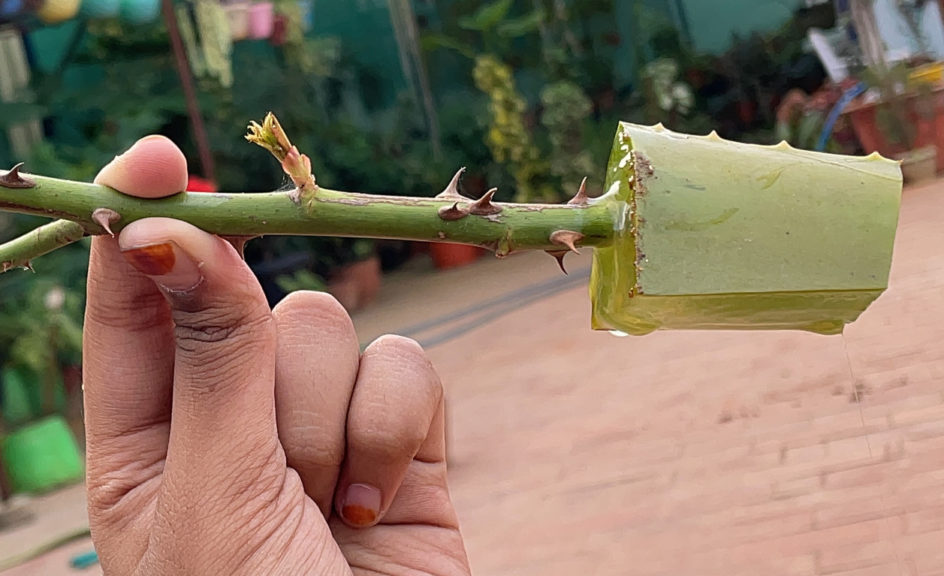
- Growing Conditions: Where to keep these cuttings? When to take out and repot them independently? And how frequently and how much to water these cuttings? These factors are very important and matter a lot for achieving best results. One common mistake people do is – taking out the cutting too early to check for roots. This happens because, when they see fresh shoots and leaves coming, they think adequate roots would have formed and they tend to remove it for transplanting. This is not right. Minimum period of at least 4 to 6 weeks or even more, is must, before sufficient roots have formed. Other factors like, A warm and humid environment is very important for rooting. Do not keep the cuttings in direct sunlight to avoid moisture loss before rooting. Keep them in indirect bright light. To maintain humidity and prevent moisture evaporation you can cover with a polythene bag and make some small holes for air circulation. You can water them only if the top soil is dry on touch or finger dip, or roughly you can water once every 2-3 days for best results depending on the climate. You can check my post on How to care for your Rose bush and get maximum flowering in Rose plant from this LINK.
Happy Gardening!
- Rooting Hack: For faster and guaranteed rooting of stem or branch cuttings, take a small piece of fresh aloe vera leaf and insert the cutting into it and then plant into the soil. Roots grow as early as 10 days depending on the plant you choose.
- Candle Hack: Seal the upper cut end of your plant stem or branch cutting using few drops of candle wax. This helps prevent moisture evaporation and result in faster rooting.
- No Browns for Composting? Use a paper shredder and use the shredded paper and card board to add into your compost bin for faster and smell free composting.
- Easy Tomato Stakes: Tomato plants require support to avoid awkward bends and also to get the best yield. String Support your Tomato plants using a small piece of GI metal wire. Make it into a U-shaped loop and insert it near the roots. Tie one end of a string to this and the other end to some support at the top.
- Banana Peel Fertilizer for Flowering: To make banana peel tea, soak pieces of banana peels in water for 2 to 3 days. Dilute this liquid with water in 1:5 ratio and water your plants to provide potassium to your plants which increases flowering in plants and also makes the flower size bigger.
- Anti-Gravity Plant Support: While growing climber veggies, do not take them to a height above 6 feet, but instead support in a slope like fashion, like take it to a height and then slope the growing ends downwards to assist in long-distance transport of water and nutrients for healthy growth. The arch like trellis is the ideal support fence for growing climber or creeper veggies.
- Hairs to Roots: Insert tomato seedlings as deep as possible to increase the density of roots formed from tiny hairy projections from tomato stems and this makes the plant stronger to produce the best yield.
- Big Leaves: To get large sized leaves in your money plant, use a moss stick or coir stick to anchor the aerial roots to it. Wet the moss stick whenever you water the money plant.
- Onion + Aloe Vera Rooting Agent: Making a paste using onion and aloe vera gel and dipping the cuttings into it for few minutes before planting in soil will help in faster and guaranteed rooting.
- Spoon Transplant: To transplant your seedlings, use a spoon, dig out as much soil with it including the roots of the plant and hold the leaves of the plant and not the STEM to pull out, because this can squeeze and damage the water and food conducting tubes – xylem and phloem and the little plant may die.
- Grow From Junk: Never throw away a pine apple crown, just remove the bottom leaves and keep the bottom inserted into a glass of water for a week and then transfer to a container. It will bear fruits within a year.
- Eggshell Water: One eggshell contains about 2gms of calcium. When you boil eggs, a small percentage of this calcium and phosphorous is released into the water. Do not throw away this water, but use it to water your plants that require a lot of calcium – like tomatoes and peppers as well as flowering plants.
- Cello Tape Pest Trap: Wrap the cello tape in reverse on your fingers and use the sticky part to touch on leaves infested with pests like aphids, whiteflies and mealybugs.
- Clay Soil Hack: Remove Clayey or sticky soil from roots using this simple Hack: When you bring your plant from a nursery and start repotting, most often you find they have stuffed the plant in a clay-rich sticky soil. You can remove this soil without damaging the roots by soaking the root ball in water for few minutes till this soil dissolves. Then you can repot this plant in a well-draining potting mix.
- Root Teasing: Always Loosen up or tease your roots before repotting into a new container.
- Toilet Paper Cloning Hack: Use Aloe vera and Toilet paper to produce roots faster during air layering your favourite plant.
- Aspirin Hack: During conventional air layering to produce faster and better roots, use one tablet of aspirin 350mg per litre of water and add this water you’re the potting mix and then wrap it around the injured stem for faster and dense root formation.
- Hydroponic Cloner: For faster rooting, make your own hydroponic plant cloner using a plastic bucket and an aquarium pump. Healthy Roots develop within 8 days.
- Free Calcium: Egg shells easily dissolve in vinegar and release free calcium to your plants. Make egg shell powder and the add about a cup of vinegar to a cup of egg shell powder and stir nicely and leave it for any hour. Then dilute this to 1:100 or more to water your plants and treat acute calcium deficiencies which can produce blossom end rot disease in your fruits and veggies.
- Simplest Plant Cloner: Use any container and place a couple of aquarium air stones to pump oxygen into the water. This helps in faster and guaranteed rooting of any plant cuttings in water.
- Wheel-Barrow: No Wheelbarrow to move garden stuff? Do not worry, the cheapest alternative is a large cloth or an old bed sheet. Just load on the heavy objects and drag it along.
- Aspirin for Rooting: When you propagate cuttings in water, do not forget to add a small piece of Aspirin tablet into it for faster and stronger root development.
- Seed Split Trick: Split the Cilatro or Corinader seeds before planting them the sand paper paper method and apply gentle scraping pressure to split the seeds and do not crush or damage them using a heavy objects like these. This helps to grow enormous cilantro harvest.
- Scrape and Sow: Use sand paper to scrape the hard seed cover of certain seeds like apple, chickoo and those with hard seed over for faster seed germination.
- Treat Leaf Curl Virus using Asafoetida: Take 500ml of sour butter milk. Add one teaspoon or about 5 gms of Asafoetida powder to it and mix well. Let it stay for 1 or 2 hours. Sieve this solution and Spray thoroughly over the affected plant including the underside of the leaves. Repeat this, every 3 days for 3 – 4 times to completely cure the leaf curl disease.
- Egg Shell Planter: You can use egg shells to sow seeds. To make drainage holes, scrape with a sand paper and use a thin drill bit to make a hole without breaking the shell.
- Egg Trays: Card board Egg trays can be used as seed germination trays. You can directly transplant the seedling along with the card board into the soil, as this is bio-degradable.
- Chalk Sticks: Chalk is chemically Calcium Carbonate. You can bury a chalk stick into the soil while planting your veggies. This really works wonders for plants like Tomatoes, Peppers, squashes, egg plants and almost any vegetable plant.
- Strong Roots: Strong Roots means a healthier plant with a better yield. In its early growth phase, adding a source of phosphorous like bone meal powder or organic rock phosphate powder will produce stronger roots and produce a better harvest.
- Seed Viability Check: An Easy method to check viability of your larger seeds is to pour them into a bowl of water. If the seeds are floating, this means they are dry and not viable. Discard them and use only those seeds that sink to the bottom.
- No Garden Gloves? Scrape your nails into a soap before working with your garden soil or potting mix. This helps in cleaning your hands easily later on and also the dirt won’t enter into your nail beds.
- Repel Animals: A simplest way to repel Some animals like cats, dogs and rabbits – is to soak a some pieces of cloth with vinegar and stuff them in some areas of your garden. These animals cannot withstand the smell of vinegar and may not return if you repeat this process for few days. Similarly using Asafoetida wrapped in a piece of cloth will deter these animals and certain insects.
- Magnifying Lens: Use a Magnifying Glass to closely examine and diagnose your plant pests and insects to identify them and follow the treatment accordingly.
- Tea Fertilizer: You can also use tea waste or coffee grounds on flowering plants as an organic fertilizer to boost blooms.
- Tea waste compost: Add used tea waste or coffee grounds into your compost bin for faster composting because earth worms digest them very fast.
- Seed Spacing: You can do perfect seeds spacing for Tiny seeds like spreading them apart in a row on toilet paper – for better visibility and even spacing and sowing. You can make a seed tapes either in a row or a square or round seed board specially for carrot seeds for even spacing and better growth and ease of harvesting.
- Over-Ripe: Garden vegetables and fruits that become over-ripe are an easy target for pests. Remove them as soon as possible to avoid pest growth.
- Faster Germination: A simple hack for faster germination and healthy seedlings is to soak seeds in Epsom salt solution for a couple of hours before planting – like half a teaspoon of Epsom salt in 100 ml of water. You can also spray Epsom salt solution on your seeds and seedlings for healthy outcome.
- Pick Small: You can Pick small seeds for sowing with a stick or tooth pick dipped in water.
- Acidify Soil: For Acid loving plants like Rose, Hibiscus or Hydrangeas, use 5gms of Alum powder in 1 litre of water once every 15 days and this will boost flowering.
- Soil PH Test Using Litmus Paper: Mix Water and Soil in 1:1 ratio. Dip the litmus paper and match the color with your color coding chart that came along with your litmus paper kit.
- A Rough Soil PH Test Method: Take a soil sample and pour some vinegar. If it fizzes and bubbles you have an alkaline soil. What if the soil is acidic? Add baking soda one or two teaspoons and mix it with soil. Then wet the soil baking soda mix with distilled water. If it fizzes and bubbles your soil is acidic, because the acidic content in soil reacts with a base or alkaline stuff like baking soda.
- Free Bio Seed Pots: Never throw away the toilet paper card board roll. But use it to make seedling cups which are bio degradable and can be directly planted into soil without disturbing roots.
- Paper pots: You can also make seed pots by rolling newspaper and even this is bio degradable and similarly you can directly transplant with the pot into the soil or into a larger container.
- Mosquito Repelling Plants: Growing plants like Lemon grass, Citronella, catnip, basil, marigolds, eucalyptus and many other plants helps deter mosquitoes.
- Turmeric Treatment: You can use turmeric powder from your kitchen treat and prevent rose-dieback disease after pruning your rose bush.
- Silica Gel Packets: Never throw away these tiny sachets, use them in your seed storage container as desiccants which increases your seed life and protects them from fungus.You can also use these to preserve and protect powdered gardening stuff like bone meal, fungicide powder, rooting hormone, etc. Just tape the sachet to the underside of the container lid and that’s it.
- DIY Watering Can: Take the base of a soda bottle and place it around one end of a pvc pipe. Heat it up with a lighter. It should shrink and clamp around the open edge. No glue needed. Use a pin and poke some holes in the bottle base. Next, cut the edge of the pipe at an angle using a saw blade. Next insert the pipe into the inlet and use some hot glue to hold it in place. Optionally, colour it to get that beautiful look.
- Mini Green House: Use plastic bins or containers as mini green houses or poly houses for faster seed germinations.
- Do Not Kill: Avoid spraying a pesticide on the flowers. This is to avoid any harm to beneficial Pollinator insects like butterflies and honey bees which are essential for pollination and fruit formation.
First and foremost, please avoid the use of chemical pesticides and fertilizers which have a lot of hazardous effects on humans and animals. That’s the main reason, why we promote the use of natural agents in this gardening portal.
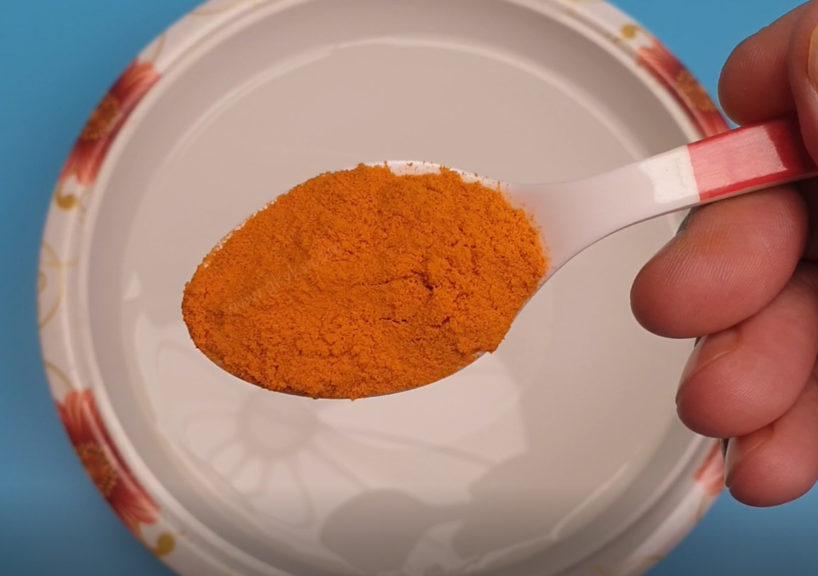
Turmeric rhizome contains a substance called Curcumin, which is a very potent antioxidant, has antimicrobial, anti-inflammatory, hepatoprotective effects, and it is very beneficial in boosting the immune system of our body. Turmeric is not only good for the human body but also has some amazing benefits in the garden. You can easily grow turmeric plant from a small piece of turmeric rhizome and harvest a lot of turmeric.
- ANT REPELLANT: Sometimes Ants, especially if there are lots of them, can be a menace to your garden. They seem to be particularly sensitive to turmeric’s strong odor.
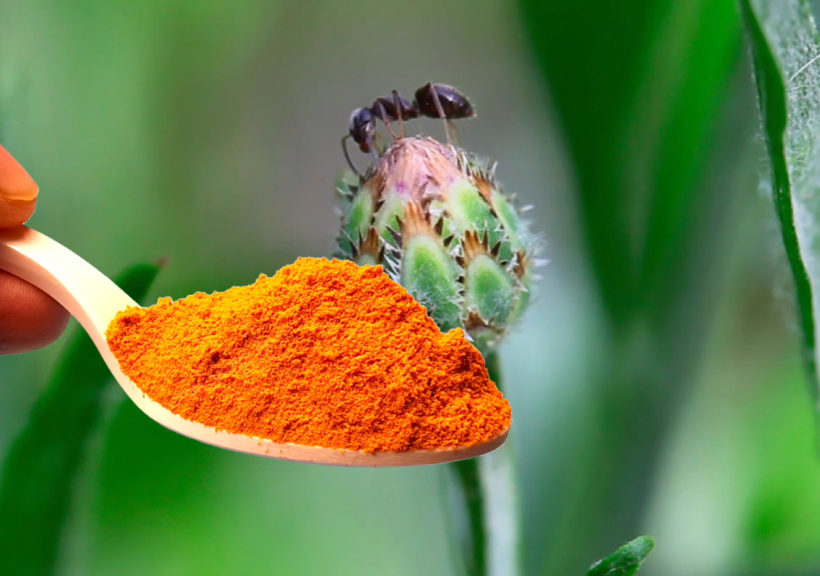
- How to Use Turmeric to Get rid of Ants? Simply sprinkle turmeric powder around your plants and even over the surface of the soil. Just few pinches and not too much. This can repel ants and help you get rid of these unwanted visitors in your garden, which can sometimes pose a serious threat by carrying mealybugs to the growing ends of plants. Yes! Mealybugs and ants have a symbiotic relationship. Ants carry mealybugs to growing ends of plants in exchange for the honeydew excreted out of their anus. So, Ant control means mealybug control.
- SOIL PEST CONTROL: You can get rid of soil pests particularly fungal root rot and fungus gnats in the soil by mixing turmeric in soil. You can mix about 1 tablespoon per gallon of soil while making your potting mix or whenever you repot your plant. Remember, adding too much of it can have negative impact on the beneficial soil microbes. The other method to use for plants that cannot be repotted, is mixing 1 tablespoon of turmeric in 1 gallon of water or 1 teaspoon per liter of water and thoroughly water your affected plant with this solution. We will shortly discuss on how to make a powerful pesticide spray using turmeric. Please watch it till the end.
- HEALING TREE WOUNDS: Similar to humans, open wounds or injuries in plants, can make them susceptible to different kinds of diseases and infections, particularly fungal rot. Due to its natural antiseptic and antibacterial properties, turmeric is also a natural remedy to heal various types of plant wounds. You can make a turmeric paste and apply over the wound to save the plant. This also helps in plant stem or branch fractures. You apply the paste and tie a polythene or grafting tape to save the plant. This turmeric treatment is also commonly used after pruning tree branches to cut wounds, also used in grafting, and any other similar situations when the plant becomes exposed to external damaging factors.
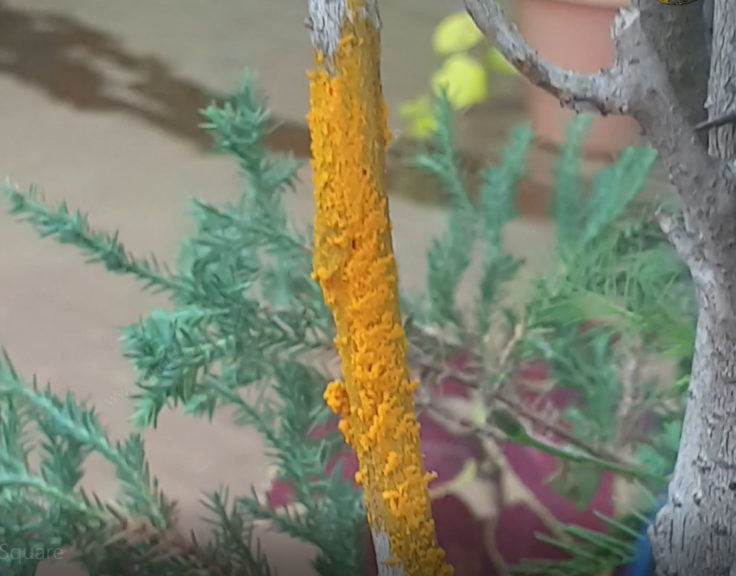
- TO TREAT ROSE DIE BACK DISEASE: Rose dieback is a condition commonly affecting rose plants where there is browning or blackening of the tip of the rose stem or a branch which then travels down toward the graft and may engulf the whole plant causing death. It can either be a Branch die back or the main stem dieback towards the graft. It is in fact a commonly encountered problem by every gardener and can sometimes be too bad causing death of the plant if no intervention is done. Though, the main treatment of Dieback disease is pruning the involved stem or branch, applying turmeric paste over the wound after pruning helps prevent progression of Rose dieback disease.
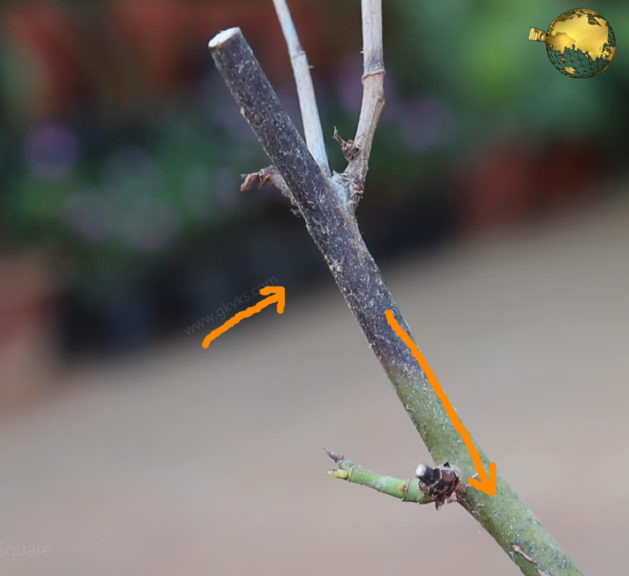
- AS A ROOTING AGENT: Though not a rooting hormone, turmeric can be used to increase the chances of rooting plant cuttings. This is mainly because of its anti-microbial and anti-fungal effects.
- PESTICIDE SPRAY: Turmeric alone as a spray can be used to treat few fungal plant diseases and pests like powdery mildew and other fungal spots. But it is not effective against pests like mealybugs, aphids, mites and other pests. For minor fungal spots and powdery mildew, you can mix 2 tea spoons of turmeric powder in 1 litre of water and spray on the affected plant.
Though there is no substitute to neem oil for pest control, you can make a powerful and broad-spectrum pesticide using turmeric and other stuff, especially if neem oil is not available in your location. You need to mix other stuff depending on what you want to treat.
- For Powdery mildew, you can mix 2 teaspoon of Turmeric powder, 100 ml of milk and 2 teaspoons of distilled white vinegar to 1 litre of water and spray on the affected plant. This is the most powerful natural remedy to treat powdery mildew.
- If Neem Oil is not Working on Certain Pests: You can add Turmeric and Garlic to neem oil solution if the pests are resistant to neem oil. You mix 5 to 10 ml neem oil in 1 litre of water and add 1 – 2 teaspoons of turmeric powder or even fresh turmeric rhizome and then add 4 to 5 cloves of crushed garlic to this mixture and sieve it fine to avoid clogging of spray bottle. Spray this once weekly. Patch test on a leaf may be important, depending on the concentration of your neem oil brand.
Money plant or pothos botanically called Epipremnum aureum is basically a vine and the most common plant found in home gardens and grown indoors in a water container. It is called money plant because it is believed to bring prosperity and good fortune to you. Well, superstitions apart!, But this is one of the NASA recommended air purifying plant. It has many common names like golden pothos, Ceylon creeper, hunter’s robe, ivy arum, silver vine, marble queen, taro vine, devil’s vine or devil’s ivy and so on.
TYPES OR SPECIES OF MONEY PLANTS OR SIMILAR PLANTS:
Golden Money Plant or the golden pothos – it has bright green leaves with golden or yellow splashes.
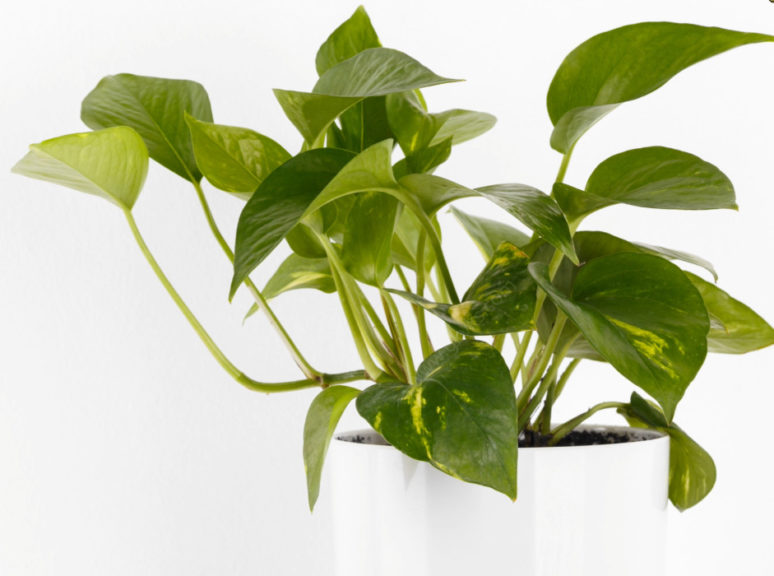
Split Leaf Money Plant or Monstera Deliciosa – This is a low light indoor plant. This is similar to Philidendeon Broken heart plant with beautiful design of notches within the leaf.
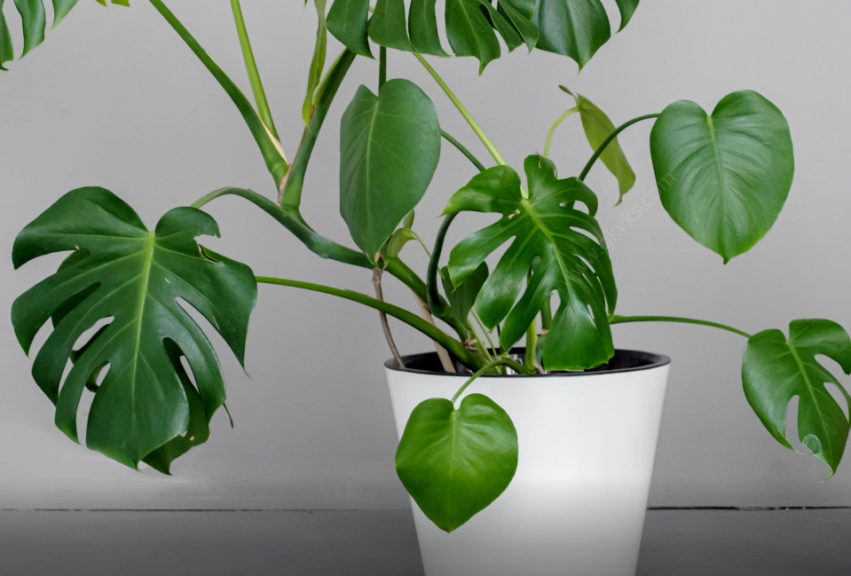
Marble Queen Money Plant – The leaves are creamy-white in color, so less green and less chlorophyll and hence this need more exposure to sunlight for proper photosynthesis.
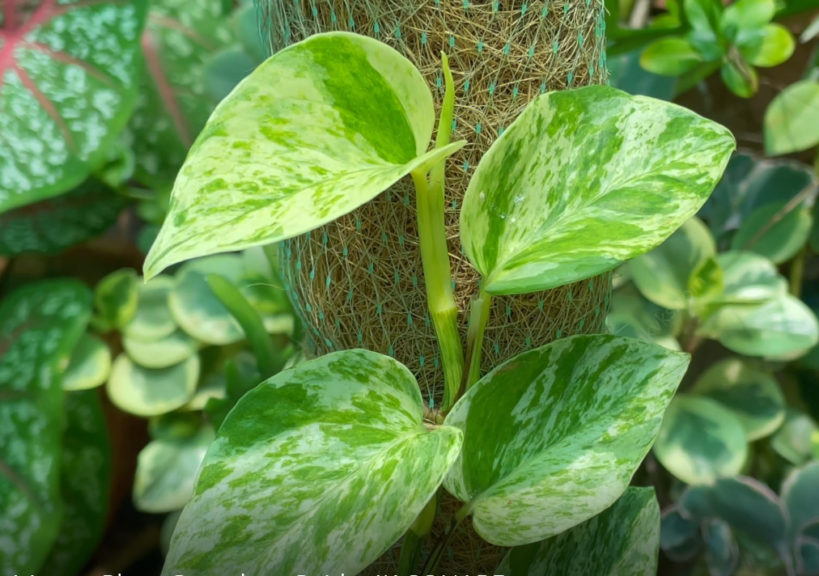
Marble Prince Money Plant – This has distinct white and green colors on the leaves.
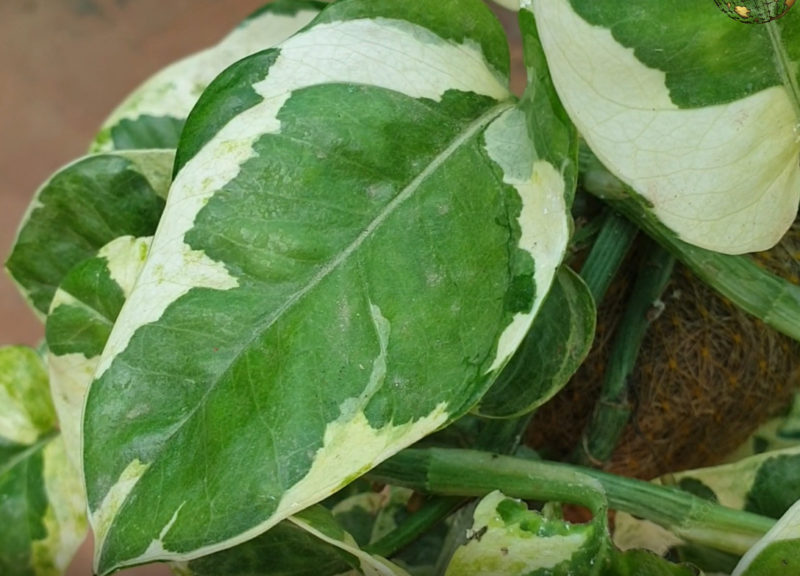
Silver Money Plant or Satin Pothos, Swiss Cheese Money Plant or Monstera obliqua, Chinese Money plant, Jade Money plant (Dark green heart shaped leaves), Neon money plant, Other similar plants but from different families include English ivy – plain and variegated, then various types of philodendrons.
Let’s first start with:
- PROPAGATION OF MONEY PLANTS: This we are discussing first because most of us do not purchase these from nursery or garden center, but instead, you get a small cutting of a money plant and try to grow at home either in water or in soil in containers. Now let’s learn some simple tricks to multiply your pothos plant easily. There are many methods of rooting money plant cuttings. One guaranteed method is soil layering – you just insert one or two nodes of a branch into the soil – mostly into a small pot. Within 2 weeks, you should start seeing roots and you can then cut of this from the mother plant and grow as an independent plant, either in water or soil. You can also successfully grow its cuttings but the most important point to remember is – planting the node into the soil and not just the stem without a node. Many gardeners show money plant can be grown from a single leaf, but this will be successful only if a node is included along with the leaf.
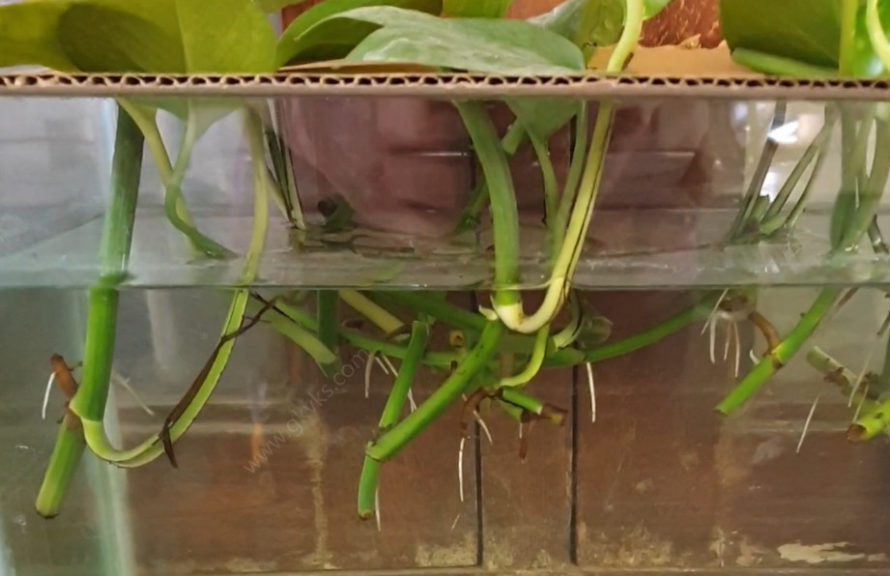
- Another Simple hack to use for faster rooting, especially if you are rooting in water is to use a quarter or half tablet of Aspirin 350 mg dispersible tablet every time you change water. You can check my detailed post on Aspirin and its benefits in gardening.
Now Let’s look into some important care tips and tricks to grow money plant. These are slightly different if you are growing them in Soil vs growing in water indoors. Let’s first quickly discuss on care of money plant in soil, like tricks on how to make the leaves bigger and how to get a bushier money plant. Also remember that they grow faster and better in soil than in water.
- Season: Money Plant can be grown in any season or any time of the year.
- Sunlight Requirement: Money plant can grow in direct sunlight as well as indirect sunlight and even indoors in your home lighting. Though, too much direct sunlight can burn the leaf edges, you need to remember this simple concept for any plant. The green color is imparted to the leaf by a pigment called chlorophyll which is essential for photosynthesis or plant food preparation in simple terms, for proper growth of the plant. If there is lesser green pigment on the leaves like in marble queen varieties or any variegated varieties, then more amount of exposure to sunlight is needed and vice versa. The best place to keep them is under a 50% shade net. They grow faster and healthier under these sun conditions. If you grow them indoors in containers, make sure you keep at the brightest spots like near entrances or near windows to get the bright light.
- Water Requirement: Money plant likes a lot of water, but at the same time it’s a drought tolerant plant and can live without water for many days. Watering Daily or Alternate days is sufficient. Make sure you water deeply and thoroughly and also check patency of drainage holes in containers to avoid water stagnation and root rot. Less frequent watering can result in burning or browning of tips and edges. Over watering can result in leaf yellowing and stunted growth.
- Soil Mix: If you provide a loose well-draining soil to money plant, the roots grow faster and hence the plant grows faster and healthy. You can mix some stuff like cocopeat or peat moss, sand, perlite, vermiculite or whatever you can, along with some 20% compost like cowdung or vermicompost to about 50% garden soil. This forms the best potting mix for money plant.
- Repotting Money Plant: This is only required when you have chosen a small container to grow money plant and the plant roots have bound to the container. If there is stunted growth and leaf yellowing, its time to repot in a larger container.
- Fertilizers: Money plants require very less amount of fertilizers and most of the nutrients are already found in the potting mix and they should be sufficient for 3 to 6 months. Because we grow money plant for its leaves, a handful of nitrogen rich fertilizer like decomposed cow dung or vermicompost, once every 3 months is more than sufficient for one standard container of money plant. Avoid using chemical fertilizers like urea or NPK as they can cause fertilizer burns. To get lush and large sized leaves, You can additionally foliar spray it with Epsom salt solution – like 1 teaspoon of Epsom salt in 1 litre of water and spray over the leaves once in about 10 days.
- Pests and Disease: Money plant is one of the top 5 pest resistance plants. So spraying a pesticide is optional. You can spray neem oil monthly once in a low dose of about 5ml per litre of water. But some diseases like fungal root rot can rarely kill the money plant. This happens mainly due to over watering.
- Now, the most important part of this episode. How to get big sized leaves in money plant? Money plants have aerial roots which are adventitious roots which are many designed for clinging and climbing on to a surface like trees, rocks and other structure we artificially provide like the moss sticks, coir sticks, trellis and so on. The concept is, these aerial roots also absorb some moisture and nutrients as well. So, taking this advantage, we have to follow these two simple tricks and hacks to get big sized leaves and lush bushy fast growing money plant. No doubt the size of the leaves also depends on the type of money plants and its genetic make up.
First Trick to Apply is: Use a Climber stick like coco coir stick, a moss stick or your own DIY gunny bag pole to anchor the aerial roots. The best one is a moss stick which is made of sphagnum moss. You can easily anchor the aerial roots into the moss and tie it up to hold in place. Make sure whenever you water your money plant, you water the moss stick as well. Liquid fertilizer like compost tea poured on to the moss stick also gives great results.
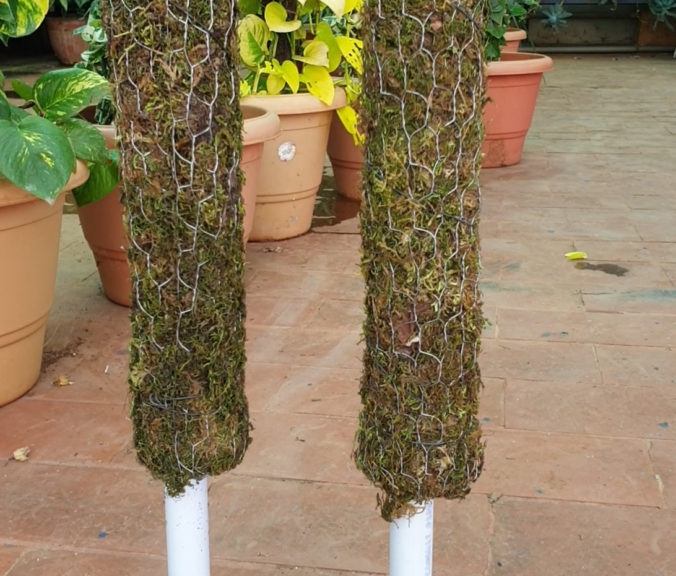
The Second Trick is: When it grows one round to the top of the pole, you take it downwards and then when it reaches the soil, you do soil layering or take a dip of one or two nodes into the same container and then take it upwards. This helps development of multiple root system that supports a short segment or a certain length of the money plants and helps in a very steady and faster growth.
Now Lastly some quick points to remember while growing money plant in water indoors.
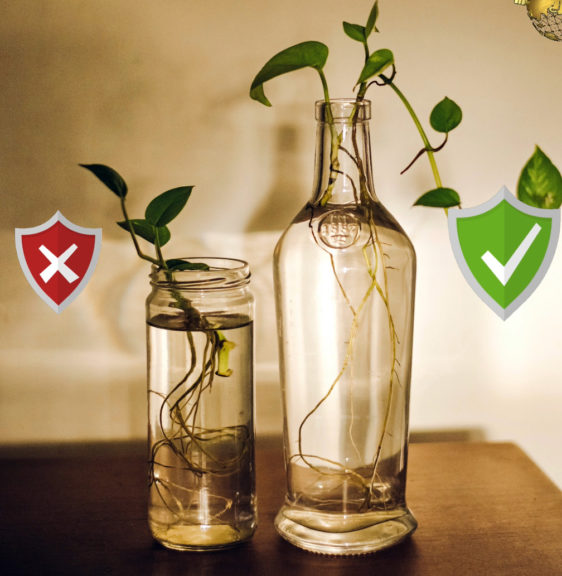
If you start from a cutting, choose a healthy cutting of about 1 foot long and must have at least 3 to 4 nodes in it. Insert at least two nodes into a clean container, preferably a glass bottle. Avoid using plastic bottles. The narrow-necked bottles are better as it provides more humidity around the main stem. Use clean water to grow money plants and change water once every 10 days for best results. Keep it in a bright location in your home like near a window. And It does not require fertilizers when grown in water.
Whether you are growing succulents & cacti indoors or outdoors, it’s really important to learn how to care for succulents and some very important Do’s and Don’ts. Let us find out how not to kill your succulents and how to keep them healthy and happy.
- MEANING OF SUCCULENT: Succulent means full of juice : juicy. So these are plants with fleshy tissues adapted to water storage. Some random examples of succulents are: Echeverias, Haworthias, Aeoniums, Gasteria, Sedums, donkey’s tail, All varieties of Kalanchoes, Jades and Crassulas, Aloe vera, All types of cactus like fairy castle cactus, Bunny ears cactus, Pincushion cactus, christmas cactus, and, the most beautiful Adeniums or Desert roses.
- SUNLIGHT: Most people think succulents are indoor plants. No doubt they can be grown indoors with proper care or that extra or special care. But succulents love full sunlight and do well with at least five or six hours of direct sun per day. This again depends on the type of succulent. And also, immature succulents or seedlings need lesser sun and have to be gradually introduced to sunlight like the Hardening Off procedure we follow for vegetable seedlings like 1-hour sun exposure for day 1, 2 hours for day, 3 hours for day 3 and so on. We will discuss more useful tips and tricks like how to avoid elongating and ugly growing succulents in the later part of this episode.
- WATERING: This is another very important factor for successful and healthy growth of succulents and cacti. The watering frequency depends on the season of the year. In spring to summer, the succulents grow to their full potential, like any other plant. And in winter season the growth is slowed down and many succulents go into a state of dormancy or inactivity, just like other plants. So, the watering requirement is drastically reduced in winter season. Now, lets talk about how to water, how much to water and how frequently to water. This is very important because overwatering can result in mold and rot and can kill the plant. Succulent and cacti are different from other plants with thick fleshy tissues like leaves or stems are adapted to water storage. So, a lot of water is already stored in these tissues and hence, the water requirement of these plants is very less compared to other plants.
While watering a succulent or a cactus, you need to stick to two rules to prevent over watering and rot. The first rule to follow is the Finger Dip method: Insert your finger to at least one inch into the soil to check the moisture. Water them only if soil is completely dry. You can also dip a moisture meter if you have. And second rule is to avoid water spillage over the fleshy leaves to prevent rot. For this you can use a watering can with a long nozzle to water over the soil and avoid water spillage over the leaves. Then thirdly water it thoroughly and deeply till the water flows out of the drain holes. Generally, in most tropical climates, watering weekly once or max twice a week is sufficient if kept in direct sun. - POTTING SOIL: This is another important factor for healthy succulent growth. Succulents and cacti need a soil mix that drains very quickly, so regular potting soil is not recommended to grow succulents. So, you need to add stuff that helps drain out water very quickly. One such succulent potting mix formula is:
30 to 40% of Garden Soil, 30 to 40% Sand, 10% to 20% pebbles or some small coarse rocks or pumice or perlite if available, 10 to 20% Compost like cowdung or vermicompost, Optionally you can add some 10% Charcoal – small pieces. Do not use cocopeat for succulents especially if you grow them indoors or keep them under indirect sunlight, because it can retain water and might result in mold and rot due to water retention.
- POT SIZE: Choosing the right sized container is also important for healthy growth of succuelnts and again this depends on the type of succulents you are growing. Most succulents have a shallow and delicate root system which do not need too deep containers and it can increase the risk of rot. For most succulents we recommend a wider shallow container for best results, because a wider container with enough space will help in propagation of succulents which produce offsets or babies from sides, which can be separated and grown as independent plants. Also make sure there are multiple drainage holes in the container you choose. You can also grow multiple succulents in a wide container. Make sure you give some spacing between each plant.
- FERTILIZERS: Succulents do not need much fertilizers, but you can give them light feedings like a teaspoon of vermicompost or decomposed cowdung once in 3 months and increase this during the active season – that’s the spring and summer season.
- PEST CONTROL: Mostly affected by mealybugs and the soil by the fungus gnats. You can spray neem oil once in about 15 days as preventive measure or weekly once to get rid of these if already infested. You can even water the succulent once with the same neem oil solution to get rid of fungus gnats. The dose os 5 to 10 ml neem oil per litre of water. The best alternative to kill fungus gnats is 250 ml hydrogen peroxide 3% per litre of water and water the soil.
- CLEANING SUCCULENTS: Wipe off the leaves and spines gently with a damp cloth to get rid of dust and this helps in better photosynthesis.
- REPOTTING: You have to take special care while repotting a succulent, because they are more prone to mold and rot after repotting. To avoid problems, always mix some antifungal powder or some neem cake powder into the potting mix during repotting.
- PROPAGATION: There are several, simple ways to propagate succulents. First method is: Growing from Cuttings: This is best applied in case the succulents have grown too leggy with elongated stems. This elongation of stem happens when there is little sunlight or if kept in indirect light. They elongate their stems for seeking sunlight. As a result they look ugly and take bad bends and turns. So, as discussed – keep them in full direct sun and make it a habit to rotate the containers once in a while to avoid bends and provide uniform sunlight. Well, coming back to propagation, Take the cuttings and leave it in air to dry for 2 days for callous formation – that’s something like wound healing and sealing to prevent rot. Then insert the cutting into a loose draining soil. Just keep the soil moist, do not water it too much. It should start rooting in 2 weeks.
The Second method is Propagating from Leaves: Yes, you can grow succulents from a single leaf. Just remove an actively growing healthy leaf from a mature succulent plant. Make sure you strip from the base, taking out the entire leaf. Leave this to air dry for 2 days and then just place it superficially over the soil. You should see a tiny plant popping out of this leaf with formation of tiny roots.
The Third Method is from Offsets or Babies, which are produced from the mother plant like aloe versa, haworthias and echeverias. Most of the succulents produce these babies which can be separated from the mother plant and planted independently.
The Fourth Method is growing from seeds: This is the slowest method to grow succulents. But if you have the time and patience, give it a try! Seeds of mature plants are located in the seed pod produced after flowering. The seeds can be collected from the pods and planted in a clean seed sowing mix or sand.
